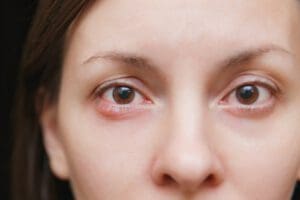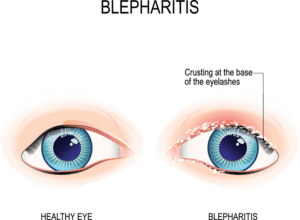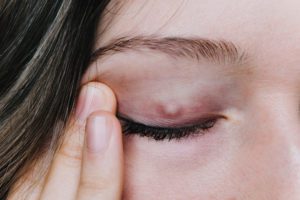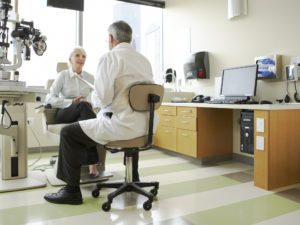How To Get Rid Of An Internal Stye
Most styes heal with minimal intervention. Knowing the right methods to use, what to avoid doing, and when to seek help from a doctor is imperative to get rid of a stye.
A stye is a common infection affecting the eyelid. Some styes can affect the whole eyelid, and they tend to be very painful.
A stye is caused by bacteria building up. There are several potential causes, such as meibomian gland dysfunction or chronic blepharitis.
Once a stye is present, the pain and discomfort encourage people to start treating it. There are many old wives' tales that can do more harm than good. It is important to only use approved treatments and methods to alleviate the symptoms.
For many styes, conservative methods that you use at home are enough to treat the problem. However, there are cases where you may need to seek treatment from a doctor to reduce your discomfort and to encourage your stye to heal.

What Are Styes?
A stye is a lump that develops under the eyelid or at the eyelash base. It is red and painful. In most cases, a bacterial infection causes styes. There are two types of styes.
- Internal: This stye develops inside the eyelid. When an oil-producing gland gets infected, this type of stye can result.
- External: This stye develops at the eyelash base. It sometimes resembles a pimple. When a hair follicle gets infected, this type of stye can occur.
When a stye first starts to develop, the eyelid can be tender when someone touches it and red. The eye may be scratchy and sore. Other stye symptoms may include:
- A small pus spot at the center of the stye bump.
- Sensitivity to light.
- Tearing of the eye.
- The sensation of something being stuck in the eye.
- Crust along the eyelid margin.
Causes of Styes
Everyone is at risk for styes. The following can increase the risk of developing a stye:
- Blepharitis, a condition characterized by oily flakes and bacteria at the eyelash base causing swelling, redness, and a burning sensation of the eyelid
- Seborrheic dermatitis, acne rosacea, or a similar skin condition
- A history of styes
- Certain medical conditions, such as diabetes

Treating a Stye Versus a Chalzion
It is important to distinguish between a chalazion and a stye before starting treatment. In some cases, they can look similar.
When an oil gland in the eyelid gets clogged, a chalazion can develop. It takes the form of an eyelid bump.
A chalazion can begin as an internal stye. A chalazion might not be apparent at first since it is often painless, or the pain is minimal. But as it gets bigger, the affected eyelid can become swollen, red, and tender when someone touches it.
Once a chalazion gets big, blurry vision can occur if someone presses on the eye. In rare cases, the entire eyelid can become swollen.
Telling the difference between a stye and a chalazion comes down to two factors:
- The pain of a stye is typically significant, while the pain of a chalazion is minimal, if felt at all.
- With a stye, the whole eyelid can sometimes be affected. With a chalazion, it is rare that the whole eyelid swells.

Home Treatments
Often, home remedies are recommended to treat a stye in its early stages.
- Warm compress. Start by applying a warm compress. Take a clean washcloth and soak it with warm water. Squeeze out the excess water and place it on the affected eye for approximately 10 minutes. Never use hot water since this could burn the delicate skin around the eyes. Do this about four times per day, using a clean washcloth each time.
- Massage: Doctors might also recommend massage, but people must be careful using this method. Gently and carefully massage the affected area. Use the fingertips for this purpose. Do not squeeze the stye or poke the eye.
- It is important to keep the affected eye clean. Warm water and tear-free baby shampoo are usually recommended for this purpose. Doctors might also recommend saline solution to break down bacterial membranes and promote drainage.
- Pain medication. Styes can cause significant pain. An over-the-counter pain medication may be recommended to reduce discomfort. Doctors may suggest acetaminophen or ibuprofen.
Before using any home remedy, it is important to consult a doctor. They can advise on how to properly use these methods. They will also accurately diagnose a stye and instruct on the best treatments for the particular situation.
In some instances, home remedies will not be enough, and medical treatment may be necessary.

Medical Treatments
Many people respond to home treatments and do not require further care. It is possible, even with home treatment, to get rid of a stye overnight or within 1 to 2 days. However, if after 48 hours of home treatments, the stye does not respond, medical treatments may be considered, according to the Cleveland Clinic.
- Antibiotics: These are usually either an eye drop or an ointment. The eye drops are applied directly to the eye, and the ointment is applied directly to the affected area.
There are cases where an oral antibiotic might be considered:
- The infection has spread to other areas of the eye.
- The doctor had to surgically drain an internal stye.
- Steroid shots: Inflammation and swelling can occur when someone has a stye. If these are significant, the doctor might recommend an injection to reduce both the inflammation and swelling. The injections use corticosteroids.
The doctor uses a small needle for this to reduce the risk of discomfort. The total procedure only takes a few minutes. Before administering the injection, the doctor may numb the area to further reduce discomfort.
- Surgical draining: If other methods fail to provide relief, the doctor might recommend surgically draining the stye. While rare, superficial cellulitis may develop as a result of a stye. This could lead to an abscess, which is a more serious infection. A mass occurs that is filled with pus and swollen. Draining this is important.
This procedure is done in the doctor's office. Following the drainage, the doctor might also prescribe antibiotics for up to 10 days to clear the infection.
If a chalazion develops from a stye and does not go away after 30 to 60 days of other treatments, the doctor may recommend surgically draining it. This procedure is also performed in the doctor's office and takes approximately 15 to 20 minutes.
The doctor numbs the eyelid before making the small incision to drain it. Within the nodule, any material and fluid are removed and drained. In most cases, people do not need stitches after this surgery.
Following the procedure, the doctor may prescribe antibiotic eye drops or cream for approximately one week. A pressure eye patch may also be applied.
Other Treatment Options
In addition to these treatments, there are eyelid scrubs that may be beneficial. There are different types of scrubs available. Some are similar to a shampoo. Gently scrub the stye and surrounding area using this type of scrub.
They contain different active ingredients. Some contain melaleuca alternifolia, a tea tree oil active ingredient, and others contain hypochlorous acid, a type of natural chemical. Some scrubs contain 4-terpineol. The scrubs with this active ingredient may be recommended if someone has underlying blepharitis.
Since styes are a type of bacterial infection, don't just ignore them. Make sure to only used approved treatments. Talk to a doctor if the stye gets worse or does not improve.
Can You Remove a Stye?
While a stye is not technically removed from the eye, it can be surgically drained if other treatment methods fail to provide relief.
While rare, superficial cellulitis may develop as a result of a stye. This could lead to an abscess, which is a more serious infection. A mass occurs that is filled with pus and swollen. Draining this is important.
This procedure is done in the doctor's office. Following the drainage, the doctor might also prescribe antibiotics for up to 10 days to clear the infection.
If a chalazion develops from a stye and does not go away after 30 to 60 days of other treatments, the doctor may recommend surgically draining it. This procedure is also performed in the doctor's office and takes approximately 15 to 20 minutes.
The doctor numbs the eyelid before making the small incision to drain it. Within the nodule, all material and fluid are removed and drained. In most cases, people do not need stitches after this surgery.
Following the procedure, the doctor may prescribe antibiotic eye drops or cream to be used for approximately one week. A pressure eye patch may also be applied.
Popping & Other Methods: What Not to Do
When a stye develops, there are certain actions to avoid since doing these things could worsen the problem. You may want to get rid of the stye as fast as possible, but ensuring safe treatment should take precedence.
Never pop a stye. This could increase the risk of further infection that could spread into the eye.
Keep the eye area clean. Avoid contact lenses or makeup until the stye heals completely. These could irritate the stye and potentially cause additional issues and more intense discomfort.
Are Styes Contagious?
Styes are not contagious. They are not spread through contact with other people. It is very rare to spread a stye to another person.
Since they develop due to bacteria, you could spread bacteria to your other eye that may lead to a stye there.
Preventing Future Styes
Cleanliness is the best way to prevent future styes. Follow these tips:
- Practice good hygiene. Always wash your hands thoroughly before and after touching your eyes.
- Remove eye makeup. Cleanse your face every night, carefully removing all makeup from around your eyes.
- Use clean towels. Never use a dirty towel around your eyes.
- Replace makeup regularly. Bacteria can form on old makeup. Aim to replace all eye makeup every six months.
References
Stye and Chalazia. American Academy of Ophthalmology.
Who Is at Risk for Chalazia and Styes? American Academy of Ophthalmology.
Is It OK to Pop a Stye? American Academy of Ophthalmology.
Treatment and Symptoms of a Stye on the Eyelid. Verywell Health.
Sty (Stye): Management and Treatment. Cleveland Clinic.
The 8 Best Stye Remedies. Healthline.
What Can I Do About a Stye? Medical News Today.
Surgery for Style. New York University Langone Health.
The information provided on this page should not be used in place of information provided by a doctor or specialist. To learn more, read our Privacy Policy and Editorial Policy pages.
How To Get Rid Of An Internal Stye
Source: https://www.nvisioncenters.com/conditions/stye/
Posted by: gunndentoory1961.blogspot.com

0 Response to "How To Get Rid Of An Internal Stye"
Post a Comment